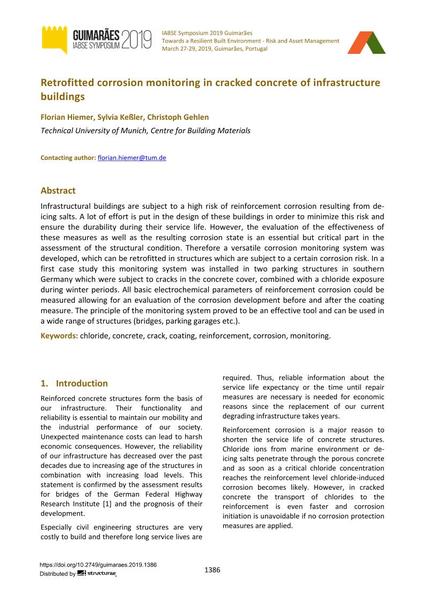Retrofitted corrosion monitoring in cracked concrete of infrastructure buildings

|
|
|||||||||||
Bibliografische Angaben
| Autor(en): |
Florian Hiemer
(Technical University of Munich, Centre for Building Materials)
Sylvia Keßler (Technical University of Munich, Centre for Building Materials) Christoph Gehlen (Technical University of Munich, Centre for Building Materials) |
||||
|---|---|---|---|---|---|
| Medium: | Tagungsbeitrag | ||||
| Sprache(n): | Englisch | ||||
| Tagung: | IABSE Symposium: Towards a Resilient Built Environment Risk and Asset Management, Guimarães, Portugal, 27-29 March 2019 | ||||
| Veröffentlicht in: | IABSE Symposium Guimarães 2019 | ||||
|
|||||
| Seite(n): | 1386-1393 | ||||
| Anzahl der Seiten (im PDF): | 8 | ||||
| DOI: | 10.2749/guimaraes.2019.1386 | ||||
| Abstrakt: |
Infrastructural buildings are subject to a high risk of reinforcement corrosion resulting from de- icing salts. A lot of effort is put in the design of these buildings in order to minimize this risk and ensure the durability during their service life. However, the evaluation of the effectiveness of these measures as well as the resulting corrosion state is an essential but critical part in the assessment of the structural condition. Therefore a versatile corrosion monitoring system was developed, which can be retrofitted in structures which are subject to a certain corrosion risk. In a first case study this monitoring system was installed in two parking structures in southern Germany which were subject to cracks in the concrete cover, combined with a chloride exposure during winter periods. All basic electrochemical parameters of reinforcement corrosion could be measured allowing for an evaluation of the corrosion development before and after the coating measure. The principle of the monitoring system proved to be an effective tool and can be used in a wide range of structures (bridges, parking garages etc.). |
||||
| Stichwörter: |
Beton Riß Korrosion Beschichtung Bewehrung Monitoring
|
||||
